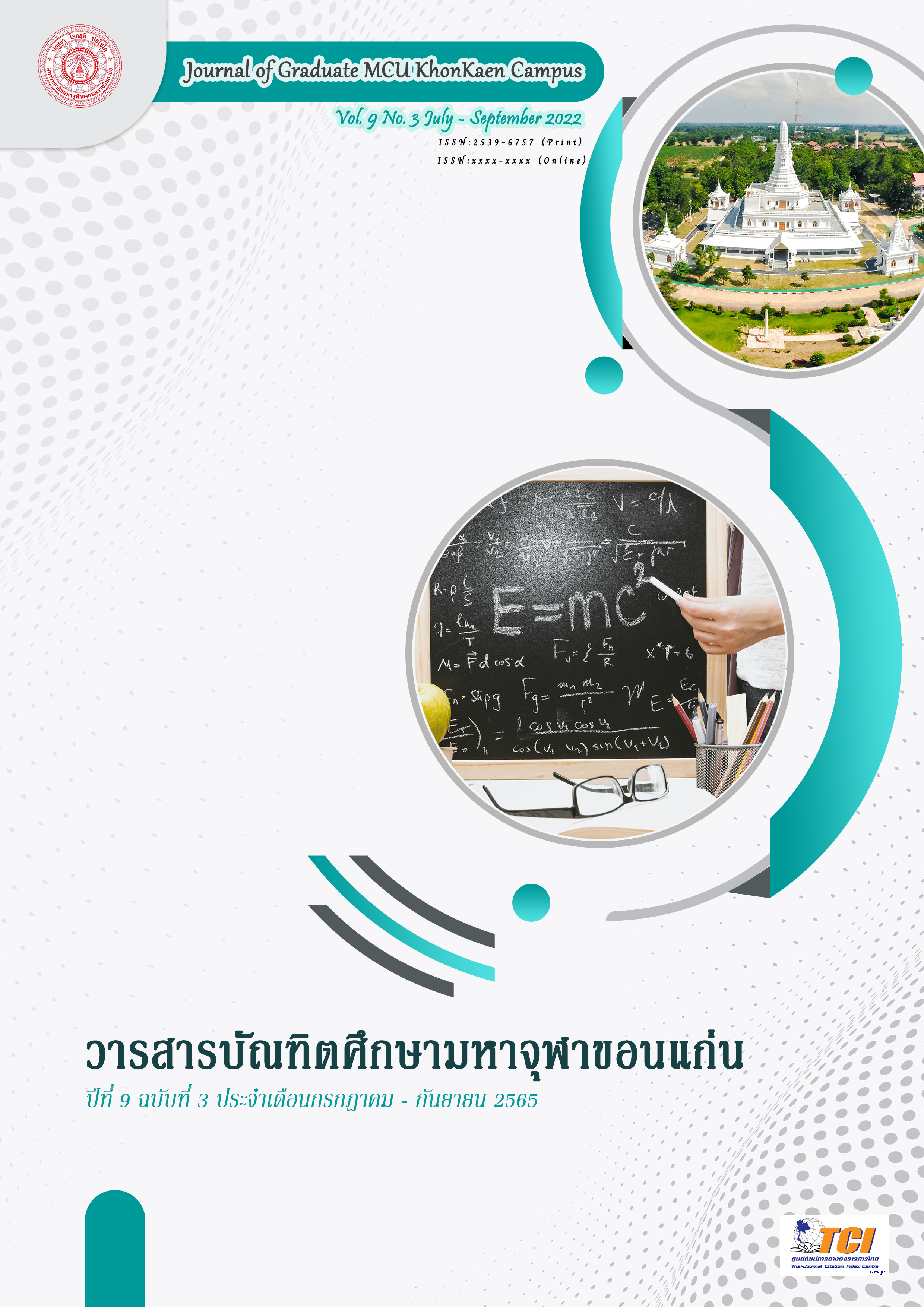Guideline for the Develop of School Adminisstrators Leadership in the 21st Century in Samsung District Under Khon Kaen Primary Educational Service Area 4
Main Article Content
Abstract
The objectives of this research were 1) to study the current and desirable conditions of 21st century leadership of the administrators of Samsung district educational institutes. Khon Kaen Primary Educational Service Area Office, Region 4 and 2) to study the 21st century leadership development guidelines of Sam Sung School administrators, Khon Kaen Primary Educational Service Area Office, Region 4. This was a quantitative research. The population and the sample group were educational institution administrators. and teachers in the Samsung district school group The research instrument was a questionnaire on current and desirable conditions of leadership in the 21st century among school
administrators in Sam Soong District. Under the Office of Khon Kaen Primary Educational Service Area District 4
The results showed that
1. A Study of the Current Status of Leadership in the 21st Century of Educational Institution Administrators in Sam Sung District Under the Office of Khon Kaen Primary Education Area 4, as a whole moderate when considering each aspect by the side with the highest average was good human relations, followed by interaction. persuasion in the use of information technology and strategic management
2. A Study of the 21st Century Leadership Development Guidelines of Educational Institution Administrators in Sam Sung District Under the Office of Khon Kaen Primary Educational Service Area 4, namely 1) the use of information technology. Executives should have training and practice in using technology media. Diversity in education management under the epidemic situation of COVID-19 2) Good interpersonal skills
Administrators should manage education with equality. honor each other and has worked like a good friend. 3) Convincing the mind Executives should create a culture of
cooperation. mutual assistance Accepting each other's opinions to occur in the organization 4) Strategic management. Executives should be open-minded. Know how to take care of him and take care of us. be friendly easy to find and narrowing the gap between people and 5) the interaction aspect. Executives should build trust confidence familiarize sociability and reduce the gap between people to occur in the organization And the results of the assessment of the suitability, conformity and feasibility of 21st century leadership
development guidelines of educational institute administrators in Sam Sung District under Khon Kaen Primary Education Service Area Office 4 were at the highest level.
Article Details

This work is licensed under a Creative Commons Attribution-NonCommercial-NoDerivatives 4.0 International License.
References
กระทรวงศึกษาธิการ. (2552). หลักสูตรแกนกลางการศึกษาขั้นพื้นพื้นฐาน พุทธศักราช 2551. กรุงเทพฯ: องค์การรับส่งสินค้าและพัสดุภณฑ์.
จิรประภา อัครบวร. (2549). ทักษะภาวะผู้นำ. สถาบันบัณฑิตพัฒนาบริหารศาสตร์. กรุงเทพฯ: มัลติอินฟอเมชั่นเทคโนโลยี.
นฤมล คูหาแก้ว. (2563). ปัจจัยที่มีความสัมพันธ์ต่อสมรรถนะการบริหารงานวิชาการของผู้บริหารสถานศึกษาสังกัดสำนักงานเขตพื้นที่การศึกษาประถมศึกษาอุดรธานี เขต 1. (วิทยานิพนธ์การศึกษามหาบัณฑิต). มหาสารคาม: มหาวิทยาลัยมหาสารคาม.
นิสาชล นามสบาย และคณะ. (2562). การวิจัยปฏิบัติการในชั้นเรียน. สืบค้นเมื่อ 24 มกราคม 2562, จาก http://www.edu.nstru.ac.th/
สมหมาย อ่าดอนกลอย. (2556). สภาพ ปัญหา และแนวทางพัฒนาสมรรถนะครูสังกัดสำนักงานเขตพื้นที่การศึกษาประถมศึกษาหนองบัวลำภู เขต 2. (วิทยานิพนธ์การศึกษามหาบัณฑิต). มหาสารคาม: มหาวิทยาลัยมหาสารคาม.
สำนักงานเขตพื้นที่การศึกษาประถมศึกษาขอนแก่น เขต 4. (2561). แผนปฏิบัติการประจำปีงบประมาณ 2561. ขอนแก่น: กลุ่มนโยบายและแผน.
สำนักงานเขตพื้นที่การศึกษาประถมศึกษาขอนแก่น เขต 4. (256). รายงานผลการดำเนินงานนิเทศติดตาม และประเมินผลการจัดการศึกษาของสถานศึกษา สังกัดสำนักงานเขตพื้นที่การศึกษาประถมศึกษา ขอนแก่น เขต 4. ขอนแก่น: กลุ่มนิเทศ ติดตามและประเมินผลการจัดการศึกษา.
สำนักงานคณะกรรมการการศึกษาขั้นพื้นฐาน. (2556). แนวทางคำชี้แจงการประเมินสมรรถนะครู. กรุงเทพฯ: กระทรวงศึกษาธิการ.
สุวิมล ว่องวาณิช. (2550). การวิจัยประเมินความต้องการจำเป็น. กรุงเทพฯ: จุฬาลงกรณ์มหาวิทยาลัย.
สุวัฒน์ จุลสุวรรณ์. (2563). การบริหารโรงเรียนตามแนวปฏิรูปการศึกษา. วารสารวิชาการ, 5(6), 29-30.
ศรสวรรค์ บุญณกรณ์ชัย. (2561). สติถิประยุกต์สำหรับการวิจัย. (พิมพ์ครั้งที่ 6). กรุงเทพฯ: จุฬาลงกรณ์มหาวิทยาลัย.
อรสา มาสิงห์ (2562). การพัฒนาสมรรถนะครูในสถานศึกษา สังกัดสำนักงานเขตพื้นที่การศึกษาประถมศึกษานครราชสีมา. (วิทยานิพนธ์ครุศาสตรมหาบัณฑิต). นครราชสีมา: มหาวิทยาลัยราชภัฏนครราชสีมา.
อัจฉณพร หิรัญอมรกุล. (2556). มาตรฐานสมรรถนะครูผู้สอนวิชาภาษาอังกฤษระดับมัธยมศึกษาเพื่อรองรับประชาคมอาเซียน. (วิทยานิพนธ์การศึกษามหาบัณฑิต). ชลบุรี: มหาวิทยาลัยบูรพา.
อานนท์ ศักดิ์วรวิชญ์. (2547). แนวคิดเรื่องสมรรถนะ Competency : เรื่องเก่าที่เรายังหลงทาง. Chulalongkon Review, 16(3), 57-72.
อาภรณ์ ภู่วิทยพันธุ์. (2552). Competency Dictionary. (พิมพ์ครั้งที่ 4). กรุงเทพฯ: บริษัท เอช อาร์ เซนเตอร์ จำกัด.
อรอุมา รุ่งเรืองวณิชกุล. (2556). การพัฒนารูปแบบการเสริมสร้างสมรรถนะครูนักวิจัยด้วยการบูรณาการ เรียนรู้ สำหรับงข้าราชการครู สังกัดสำนักงานเขตพื้นที่การศึกษามัธยมศึกษา เขต 2. (ดุษฎีนิพนธ์สาขาการศึกษาผู้ใหญ่). กรุงเทพฯ: มหาวิทยาลัยศรีนครินทรวิโรฒ.
อุทุมพร จามรมาน. (2544). การวิจัยทางการศึกษา ในประมวลสาระชุดวิชาการวิจัยและสถิติ และสถิติทางการศึกษา หน่วยที่ 1. สาขาวิชาศึกษาศาสตร์ มหาวิทยาลัยสุโขทัยธรรมาธิราช.
Brog, W.R. & Gall, M.D. (1989). Educational Research. New York: Longman.
Dotun Adebanjo. (2010). An Investigation of the Adoption and Implementation of Benchmarking. International Journal of Operations & roductionManagement, 30(11), 1140-1169.
Hamdan, A.R., M.G. Najib and L.H.L. Ting. (2010). Teaching Competency Testing Among Malaysian School Teachers. European Journal of School Sciences, 12(4), 610-616.
Hendry Raharjo. (2010). Dynamic Benchmarking Methodology for Quality Function Deployment. Benchmarking : An International Journal, 17(1)

